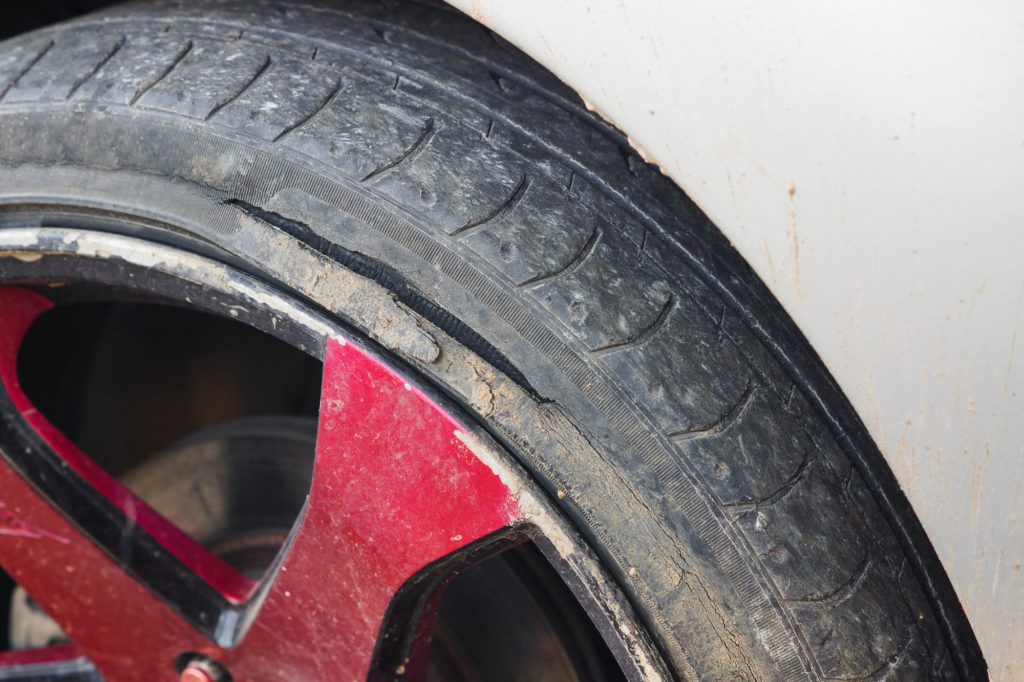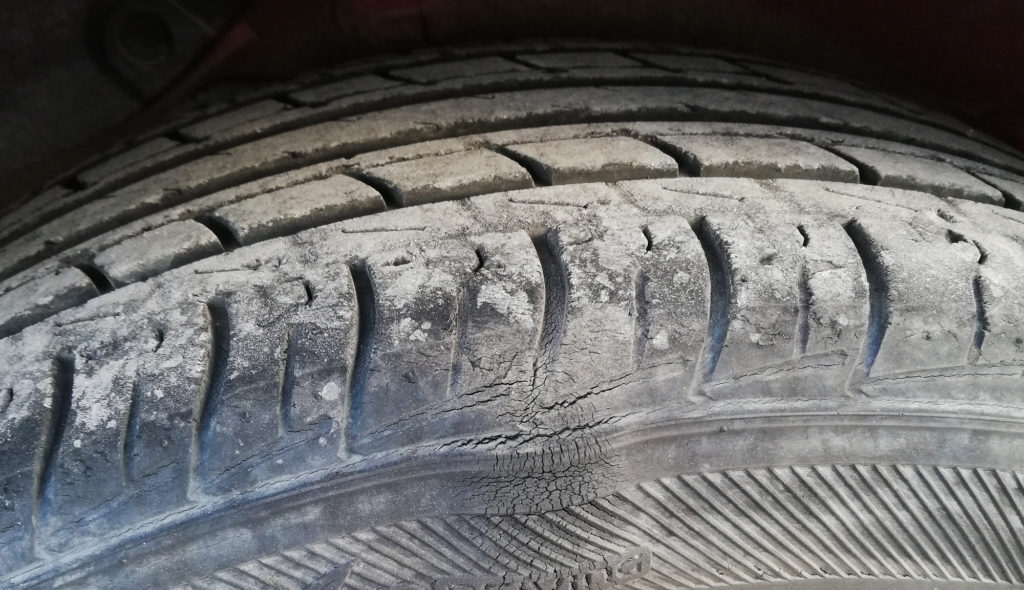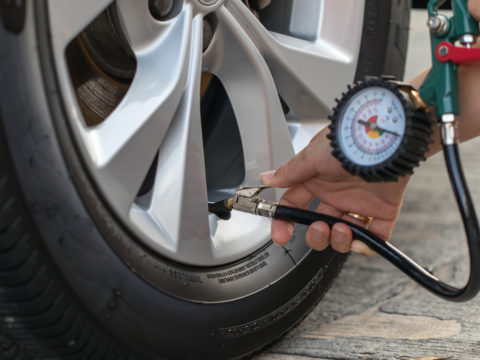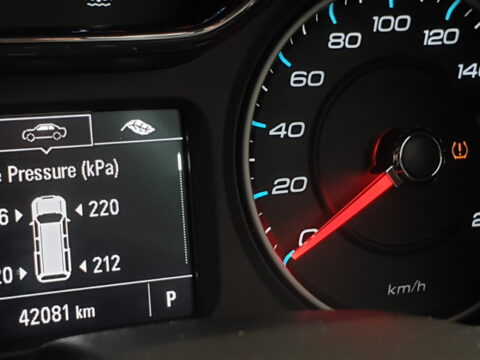Getting a flat tire is a huge pain. When you have a simple puncture, that’s bad enough. But when you have tire sidewall damage, it’s even worse.
Let’s look at some more facts about tire sidewall damage, how it happens, and what you need to do to get it fixed.

Contents
How to Assess Tire Sidewall Damage?
There are two main parts of a tire. The tread is the part that makes contact with the road. The other part of the tire is the sidewall. The sidewall refers to the part of the tire from where it contacts the rim to the corner of the tread. If you look at a tire, the sidewall is the part where you see the manufacturer’s brand and the sizing info.
Sidewall damage refers to any punctures, scuffs, rips, tears, bubbles, or cracking of this part of the tire. Since the sidewall is visible, unlike much of the tread, it’s pretty easy to spot sidewall damage. Even a casual look around your car can reveal any issues.
Here’s a good look at a major bubble on a sidewall.
How Does Tire Sidewall Get Damaged?
There are quite a few ways tire sidewalls can get damaged.
1) Wear and Age
As tires get older, they start to break down. Even during their estimated service life, which is usually a maximum of ten years, tires wear down. The harder you work your tires and the more miles they’re driven, the faster they degrade. So, if you start seeing cracking on the sidewall surface, it’s possible you need to replace your tires.
2) Not Enough Air Pressure
Underinflated tires are dangerous, as they can lead to loss of control. A lack of sufficient air pressure can also decrease your fuel mileage. And, when you drive a car with low tire pressure, the tires themselves are subjected to more load across the sidewalls.
That increased load can degrade the integrity of the sidewalls, leading to a lack of flexibility in the tire. Finally, leaving the tires underinflated can result in a slow breakdown, cracking, or even acute damage like blisters and bubbles.
3) Curbs and Obstacles
If you hit a pothole or a curb with enough force, the sidewall of your tire may bubble. When you see a blister or a bubble on the sidewall of a tire, that means its integrity has been compromised. While the damage might be relatively minor and the car is still driveable, the tire is unlikely to stand up to the next obstacle and might even blow out more easily.
4) Overload
If you like to pile gear into your car or truck, or transport heavy loads, you may end up damaging your sidewalls. Tires and the vehicles carry ratings for the maximum weight capacity they can handle. If you load the vehicle so heavily that you exceed that maximum, it may end up damaging your sidewalls.
5) Accidents and Foul Play
Sometimes, accidents happen. It’s possible that someone could scrape your tire with their own, causing sidewall damage. Even worse, sometimes people damage tires on purpose. Criminals and vandals often target sidewalls of tires, as they’re relatively easy to damage with a knife.
When they use a blade or a sharp object to cut the sidewall and ruin a tire, it’s called tire slashing.
How to Check Tire Sidewall Damage?
Thankfully, sidewall tire damage is usually pretty easy to discover. That’s because the outer sidewalls are exposed and visible. The outer sidewall is the part of the tire most likely to be scraped along a curb or damaged by a vandal. So, most of the time, you’ll see any damage without even having to get down on the ground.
Don’t forget that there is an inner sidewall too, which is unfortunately not as easy to see. To look behind the wheel and inspect the inner sidewall, you’d have to jack the car up. Sometimes, you might be able to lay on the ground and look and feel along the inner sidewall for damage, but it’s a pretty tight squeeze on most cars. You’ll have more success on SUVs and trucks.
How Much Tire Sidewall Damage Is Too Much?
Anything more than a minor scuff on the surface of the sidewall is too much. Once damage enters the carcass of the tire, it’s no longer safe to drive on. The sidewall carries the load of the car, and if it’s damaged, it becomes more susceptible to blow out (the catastrophic loss of air pressure).
If that happens while sitting still, you’ll have a flat tire. If that happens while you’re taking a turn on the highway, you could easily lose control of your vehicle, leading to increased risks of crashing, including a rollover crash.
Can a Damaged Tire Sidewall Be Fixed?
Unfortunately, damaged sidewalls can’t be fixed. That sort of damage ruins a tire’s integrity, and it must be replaced as soon as possible.

How Do You Fix It?
Since you can’t fix a damaged sidewall, you’ll have to get a new tire put onto the rim. Here’s how to do so.
Tools and Equipment Needed
To change a tire, you’ll need to first call your local tire shop or mechanic and have them order a tire. Alternatively, you can order a replacement tire online. Just remember that mounting a tire requires specialized equipment, so you can’t do that part on your own. You’ll also need a few other tools, including:
- Floor jack
- Jack stand or cribbing
- Lug wrench
- Breaker bar (optional)
Loosen the Lug Bolts
Before you jack up the car, it’s a good idea to get a head start on loosening the lug bolts that hold the wheel to the hub. Once the car is in the air, if you have to really work hard to loosen the bolts, you could accidentally rock the car off the jack stand. So, it’s a good idea to get the stubborn lug bolts started on the ground.
To do so, put your lug wrench on the first bolt and try to turn it counter-clockwise. If it’s too hard to do by hand, you can use your foot to try and get it spinning. If you have access to a breaker bar, now is the time to use it to get additional leverage on the lug wrench. Work your way around the lug bolts (there are usually four or five) until each one is loosened a quarter turn.
Jack the Car Up
Now that the bolts are loosened, you can jack the car up into the air using a floor jack. Make sure to use the proper jack points for your car. Make sure the tire is off the ground high enough for you to remove it, you’ll need at least an inch of clearance.
Consider using a wheel chock against the opposite corner’s tire to block the car from shifting or rolling.
Set Your Jack Stand
It’s not safe to work under a car that’s held only by a jack. If the jack fails, you could be seriously injured or killed when the car comes crashing down. So, for safety, always use a quality jack stand to hold the vehicle in place.
Alternatively, you can also use stacks of wood, or cribbing, to support the car’s weight.
Remove the Lug Nuts and Wheel
Now that the vehicle is lifted and safely supported, you can remove the lug nuts the rest of the way. With the bolts off, the wheel and tire should slide off the hub. If it seems stuck, give the side of the tire a good whack with the heel of your hand. A couple of sharp blows will loosen it, and you can then wiggle it off the rest of the way.
Replace the Tire
With the wheel and tire removed from the car, you can bring them to a repair shop. If you bought your own tire, you’d only pay to dispose of the old one and mount and balance the new one. Or, you’ll pay the shop for the mounting and dismounting, as well as the cost of a new tire.
Reattach the Rim
With your new tire mounted to your wheel, you can reinstall it on your car. Then, refasten the lug bolts in a star pattern so they tighten evenly. Remove your cribbing, lower your jack, and take a test drive. You’ve successfully replaced your damaged tire.
Can You Drive on a Tire with Sidewall Damage?
Driving on a damaged tire is risky. Doing so makes it more likely you will have a catastrophic failure of the tire. If that happens, you could crash and be hurt or killed. You could even kill someone else. So, it’s important to replace a tire with sidewall damage promptly.
If you must drive on a damaged tire, do so with extreme caution.
Final Verdict: to Fix It or to Buy New Tire?
The bottom line is that repairing a tire sidewall is impossible. So you’re going to have to replace your tire if it has sidewall damage.














